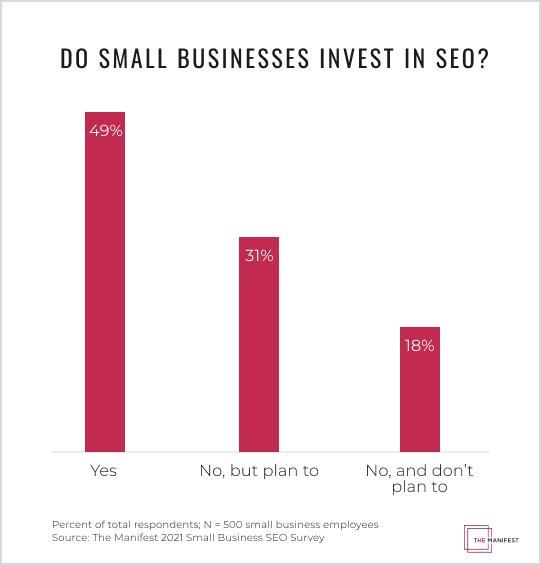The Best SEO Strategies for Small Businesses in 2022


Search engine optimization can transform your business journey. It’s a valuable tool for improving your online presence, boosting brand awareness, and gaining more leads. The fight for users’ attention is crucial, even though it’s estimated that 5 billion people use the Internet in 2022.
That’s over half of the world’s population! Yet, try to remember the last time you were looking for something on the 2nd or 3rd page of the Google search results.
Unless it’s a research paper, you’ll click on the first couple of links.
This brings us to the point that in your niche, you have to be high in the rankings. And SEO is one of the most powerful tools for achieving that.
In this article, we’ll cover 7 top small business SEO strategies that will help you grow your company’s authority online.
How Big Influence Can SEO Bring to a Small Business?
SEO isn’t only for large corporations. Small businesses can also benefit from optimization in multiple ways:
- Brand awareness boost.
If you’re on the first results page, get a featured snippet, or your Google My Business profile appears on the page, more people will find out about you and potentially become loyal customers.
There’re proofs it takes about 7 impressions for someone to remember your brand and buy from you. This proves the importance of proper brand awareness. And bigger business awareness means bigger revenue.
- More targeted traffic.
When you learn what keywords to optimize for and identify the searcher’s intent, you find out what content they are looking for and what stage of the user journey they are on. Once you know that, you can get the most relevant people to the right pages, providing potential buyers with information about your brand, products and services, and purchase terms. The better you meet their expectations and search intent, the greater the chance of selling!
- Beating the competition.
Obviously, a smart SEO campaign will help you beat the competition and appear higher in the search results. Why is that important? Because the average click-through rate of the first result is 28.5%. The second result has a dramatically lower average CTR of 15%, followed by the third result with 11%. And the further it gets, the worse it gets ...

Although there are many benefits to using small business search engine optimization.
Only 49% of companies do so. 31% plan to do it, but will they?
Why do some small businesses neglect SEO?
First of all, it’s due to a lack of time. Many business owners realize they can do something SEO-wise to help their websites rank higher, but with so many responsibilities, focusing on optimization may be tricky.
Then, there’s the question of budget. If you don’t have the time to optimize your website and get high-quality backlinks, you can hire a specialist. But that, along with the marketing budgets you have to include in your monthly plans, can be troublesome for some businesses.
But don’t worry. You won’t need to spend thousands of dollars a month on marketing and in-house specialists. Usually, small businesses compete on a local level with other companies similar to theirs. This makes the budget much lower.
Before You Choose Your SEO Strategy…
- How people search
- Who you want to reach with your campaign
- What problems you can solve for them
For that, you should answer the following questions:
- In what circumstances do people need these products or services? How do they do it, when they do it?
- Is it something they need for themselves like good food or entertainment?
- Is it something caused by a problem at home or at work?
- What will they use to look for businesses to solve their problem? (PC, phone, etc.)
The answers to these questions will help you determine the type of keywords to look for and the content to create for your website. For example, when looking for a restaurant nearby, a person may use their phone on the way from their office. They may even use voice search since it’s rapidly gaining popularity.
TOP Small Business SEO Strategies
A successful small business SEO strategy is a combination of:
- Proper content
- High-quality, relevant backlinks
- No technical issues
- Local optimization
Good news – we’ll cover all of these points and more in this section.
1. Competitor research
Simply put, learn what your competitors are doing, then do it better.
Keep in mind that your offline and online competitors may differ, and that’s OK. As we’ve established in this article, roughly half of small businesses turn to SEO to improve their online visibility.
So, what you should do is type the focus keyword you want to rank for in Google search.
Source: Google
After some businesses ranking first on Google Maps and a couple of links to directories and TOP lists, you’ll come across the websites of your online competition.
Directories are more about backlinks than organic results, however, they will help you a lot later. The companies that have homepages and other pages ranking high in the search are the main focus at the moment.
To make sure you can analyze them properly, you need digital tools that will help you find out:
- The exact keywords the websites rank for
- How good their backlink profiles are
- How many pages are indexed
- Whether there are any long-tail keywords in their directories that you can target much easier and faster than short tail keywords.
Also, you’ll need to test the speed of these websites, since it’s one of the factors Google uses to rank websites. Page Speed Insights tool may help in that.
Last but not least, look for gaps in the strategies of your competitors to know what you can do better or differently to rank higher!
2. Build connections, not just backlinks
Inbound links are essential when it comes to SEO for business. First of all, you should find out where your online competitors are getting them. For that, you can check SE Ranking backlink checker software.
Source: SE Ranking
Simply enter the domain of your competitor, and you’ll find out its:
- Domain trust
- Page trust
- Anchor texts
- Referring domains
- Backlinks
- Dofollow/Nofollow links
- Top backlink anchors
By understanding where they get those links, you can plan your future backlink acquisition campaign. You’ll also be able to see what links work best and contact those websites for cooperation.
Remember that Google values the quality of inbound links. So, you need to place them in expert content tailored for your target audience.
Consider writing guest blog posts for relevant websites with a mention of your site. This creates a personal feeling from the actual business, which builds trust with your target audience.
Guest blog posts come in various shapes and sizes:
- Guides
- Educational content
- Recommendations
- Cases, etc.
This will not only help you jump higher in Google rankings but also get more referral, very valuable traffic.
Our tips
Great idea is to cooperate with influencers in your field and create engaging content with them. People will link to this content and share it on their social media with pleasure, which will boost brand awareness and probably drive more sales.
Also, consider creating video content. People tend to become more engaged when they see video content since it’s entertaining and easy to comprehend. After all, we process visuals 60,000 times faster than text (That’s one of reasons, why TikTok became so popular in such a little time…).
3. Create catchy, engaging content about your offers
Small business website SEO, to some degree, revolves around the content you create. Make sure you have:
- Structured commercial pages that focus on your products and services, so that people know what you sell.
- Informational blog posts with clear explanations of what your business does and why users should choose your company.
- Engaging posts on topics your target audience wants to talk about or get insights into.
Utilize long-tail keywords. They are longer and more conversational, which will help you optimize the page more precisely. Besides, such queries are often used in voice search because they sound more like questions, which will give you more chances to rank higher.
Research the keywords, find out the search volume of the chosen queries, and get more ideas with tools like Google Adwords and SE Ranking Keyword Research. Unfortunately, many small business owners limit their content to contact information and the location of their office. Instead, they could fill this space with FAQs, useful educational content, and vivid descriptions of the benefits their products and services offer.
4. On-page optimization
There are lots of elements you can optimize on the page:
- Title tags
- Meta description
- Subheadings
- Media content
- Body content
- Internal links
Use focus keywords in the title tags, meta description, subheadings, body content, the names and alt-text of the media content, and even the names of the files.
Link to other pages of your website to encourage users to spend more time there and find out more info about your company, its values, and offers.
5: Local search optimization
In 2022 local search is essential for small business SEO because many businesses compete mostly on the local level. To rank higher, you have to let Google know the most important information about your company.
Here are best tips:
- Keep your NAP consistent.
Name, Address, and Phone number have to be consistent throughout the online mentions of your business. This includes your website, Google My Business, Google Maps, the directories you’re mentioned in, and all other local citations (any online references to your NAP).
- Use structured data.
Schema.org data for rich snippets will help you tell both search engines and users what your business is about. These snippets get a higher click-through rate because they offer more information about the website. You can add your NAP, a map to the store, images, reviews, and more there.
- Build trust through sharing your expertise and reputation.
Ask customers to leave reviews about your company, and show that you’re a trustworthy business by replying to those reviews. 59% of Internet users read Google reviews before considering a company.
Source: https://www.oberlo.com/blog/online-review-statistics
6. Take care of these simple technical aspects
Focus on the technical aspects of your website:
- Perform broken link check.
You can do this in Google Analytics > Behavior tab > Site Content > All Pages. By default, you’ll have the “Pages” setting. Change it to “Page Title”. This allows you to filter pages by their title. In the Advanced option, insert your 404 page title. And don’t forget to mark the time period you want to check. Do it monthly to make sure you don’t have any broken links that will hurt your site performance.
- Check for duplicate content.
The easiest way to do this is to copy ~10 words from one of your pages and enter it into Google search in quote marks. You can also use Copyscape.
- Check accessibility for search bots.
This is the crawlability of your pages. You can use the robots tags to see if any of the essential pages have the ‘noindex’ or ‘nofollow’ tag.
- Check the loading speed.
Use Google’s PageSpeed Insights to find out how fast your pages are loading. Basically, the lower the waiting time, the better.
7. Improving CTA elements
Work on CTA elements throughout the sales funnel:
- Links
- Banners
- Buttons
Consider various text, colors, sizes, and placing to ensure you provide a convenient user experience and encourage people to convert into buyers. Test different options and see which one brings you the best results.
Key Takeaways
- SEO has a lot of benefits: boosting brand awareness, drawing more traffic, beating the competition.
- There are misconceptions about the budget and effort you have to put in SEO.
- Search intent should be a very important aspect of your SEO strategy.
- Competitor research, link building, engaging content, proper CTAs, on-page and technical SEO, as well as local SEO are all great strategies for small businesses.
- Find competitors by typing your focus keyword in Google search. Next use digital tools to deepen the research.
- Build links with networking in mind and choose only relevant websites with a high Domain trust.
- Target audience's concerns and frequent questions in your blog posts and don't forget about structured commercial content.
- Add the focus keyword in the title tags, meta description, subheadings, media content, body content, internal links, etc.
- To rock the local SEO, keep your NAP data consistent, share your expertise, and use structured data.
- Technical SEO requires you to check the website for broken links, duplicate content, accessibility issues, and loading speed, trying to fix the problems ASAP.
- Make your CTAs short, interesting, and personal to get more leads.
It takes a lot of effort, but the results are worth it. You’ll notice some slight positive changes several weeks after you start. Imagine what you’ll achieve in a year.

Digital Marketing Manager at SE Ranking with experience in SEO, digital and content marketing. She's a persistent advocate of using content marketing to build a solid brand. In her spare time, she's dedicated to reading.


